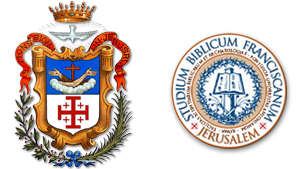...................................
[read in Italian] ![]()
The illustrations of both editions were made using intaglio plates. Accordingly, the credit of the precious plates cannot be tributed only to Bernardino Amico, but also to whoever engraved the friar’s drawings. Even though this last (but not least!) person is often anonymous, in this case the names of the artists involved respectively in the first and the second edition are known.
The 1609 title page states that the plans were «shaded and engraved by Antonio Tempesti of Florence», that is Antonio Tempesta (1555-1630), a painter, drawer and engraver active between his hometown, Florence, and Rome. Among his contributions to book illustration, for instance, there are his three series for Torquato Tasso’s Jerusalem Delivered and the images in Evangelia arabica et latina printed in Rome by Tipografia Medicea Orientale in 1591 (edition displayed during the exhibition The Bible on the move, item C.2). Working on Amico’s plans, Tempesta did not just engraved the plates, but he also contributed shading the friar’s austere drawings.
| [click sulle immagini per ingrandirle / click on images to enlarge] |
The engraver involved in the second edition might have been French Jacques Callot (1592-1635), who was active in Florence at that time and became famous for works such as the series Les Misères et les Malheurs de la guerre and Balli di Sfessania. Where Tempesta only added shades to the buildings drawn by Amico, which consequently look uninhabited in the first edition, Callot tried to solve this sense of estrangement by adding friars and other people and even a fantasy element: he depicts three scenes from the Gospels on the side walls of the Basilica of Bethlehem, where in reality there are mosaics showing completely different subjects.
